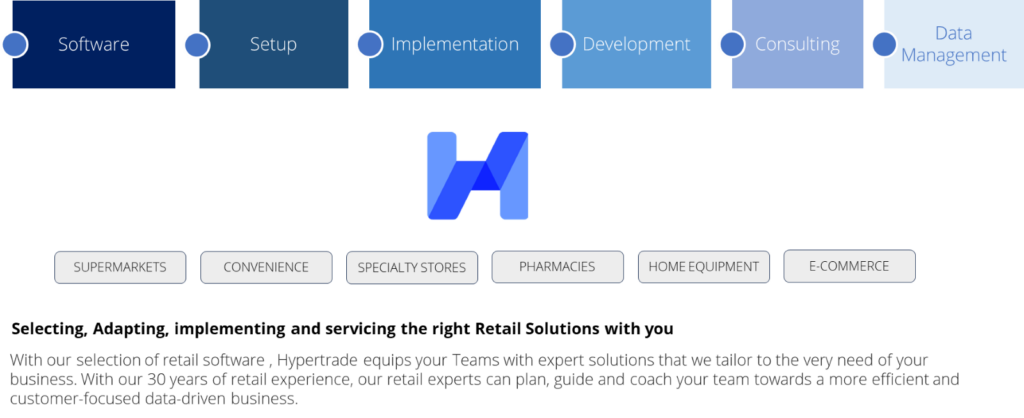Is your ERP limiting your Segmentation? Bypass it!
From the very beginning, the products a Retailer offers to its customers are classified based on its Merchandise hierarchy, also called structure or product hierarchy. The Merchandise hierarchy enables Retailers to organize their products into different categories and sub-levels, making it easier for
- their Customers to find the products they are looking for while shopping in-store or online. For most Retailers, Products are displayed according to the Merchandise Hierarchy they belong to.
- their Operation Team to display products in a logical pattern and quickly identify where a new product should be displayed.
- their Analysis, easily identify which Division, Department, Category, or Sub-Category is performing or not based on Sales, Margin, and Inventory.
Ideally, retailers enjoy having several segmentation levels, this creating a granularity that supports finer analyses and better decisions.
Challenge
The lack of granularity was preventing Merchandisers and Buyers to understand customers’ preferences an take the relevant category decisions. It translated in decreased cashflow, and non-optimized sales opportunities.
Due to its ERP limitations to only 3 levels of Merchandise Hierarchy, our Client – an Hyper and Supermarket Chain with a national presence with above 70 stores – and its Team struggled in their product segmentation. Because they had to gather several different types of products in similar groups, they were not able to detect:
- Which Sub-Category was the main sales or margin contributor of the Category
- Which Sub-category was having too many
- Which Sub-category was performing well among other Sub-Categories within the same Category
- If the space allocated was sufficient or not to display the number of products belonging to the Category
For example, in the Electronics Division, the next sub-level of Merchandise Hierarchy in our Client Merchandise Hierarchy was TV, Sounds, Computers & IT, Appliances, and Small Appliances.
When drilling down into Small Appliances, the next sub-level was Food preparation, then all products belonging to Food Preparation were attached to it.
Buyers and Category managers were naturally struggling managing the 600 skus of the Food Preparation group, not being able to know sales and margin contribution of, for example, Rice Cooker, Blender, Food Processor, Juicer……
Action
To bypass the limitations of the ERP, a virtual merchandise hierarchy was built in our cloud-based retail merchandising solution, supported by automated mapping of each skus.
Putting the Client’s ERP on the side for a moment,
the 1st step was for our Client’s Merchandise Team to build their ideal Merchandise Hierarchy. It was a practical and detailed approach of What Good Looks Like. The exercise enabled the Team to create 1,927 sub-categories, whereas their ERP was limited to 492.
The 2nd step was to map each existing product from the existing ERP Merchandise Hierarchy with the new one they just built. Using key words in products description, the 80,000 Skus of their current assortment were successfully mapped.
The 3rd step was to automate the mapping from the ERP to our Retail Merchandising solution and ensure this mapping would be flawless.
The 4th step focused on defining the business rules required to map every new product coming into the assortment, from the ERP to the Retail Merchandising solution.
In just 3 months, our client’s Teams was able to reach a level of granularity that was not possible in the past. And they started to immediately see where the improvement levers were.
For instance, and back to our Food Preparation Category example, the Category Manager discovered that its Top Sub-Category was Kettle with 40% of the Share of Sales for 29% of Share of Assortment and only 25% of Share of Space but the Sub-Category Sales growth was at 2.2% when Electronics was growing by 5.1%. Based on Kettle performances the Team then decided to allocate more space and redefined the number of Products for the Kettle Sub-Category.
In opposition to Kettle Sub-Category, Toaster Sub-Category had a Share of Sales of 2% with a Share of Assortment of 7% and a Share of Space of 10% when the Sales Growth was negative. Then the Team decided to reduce the number of Products and space allocated for the Toaster Sub-Category.
The Merchandise Team reviewed their entire Assortment allocation based on those principles:
Share of Sales, Share of Assortment, Share of Space to improve their Assortment effectiveness. They increased or maintained the Number of SKUs for Sub-Category having potential growth but having big gap between their Share of Assortment, Share of Sales, and Share of Space, and they reduced the Number of SKUs for Sub-Categories over displayed and having too many SKUs.
Results
In addition to massive savings in ERP upgrades, The assortment was optimized, with direct and measurable impacts on sales, profitability and cashflow.
After 3 Months for Food Preparation
- Sales Growth is + 8.9% and Kettle Sub-Category is having a 17.2% Sales Growth
- Margin Value improved by 12.4%
- Total Assortment for Food Preparation reduced by 29.6%
- Stock Days reduced by 14 Days (12.8%)
What does this show?
Having the possibility to segment and drill down till Sub-Category or segment allows Category Manager to have a more granular vision of its Category and to take actions and decisions based on performances.
- Easily and quickly identify which are the Sub-categories underperforming.
- Manage Share of Space Vs Share of Sales Vs Share of Assortment
- Assign a fixed Number of SKUs by Sub-Category with a basic principle (One-Product-In, One-Product-Out)
On our side, we were of course happy to see that our Tool and Expertise are helping create the right value for our client and help strengthen their Assortment efficiency.
What does it demonstrate?
Effective assortment management requires a certain level of granularity. Investing time in building this granularity deliver almost immediate results for all stakeholders:
- Easily and quickly identify which are the Sub-categories underperforming.
- Manage Share of Space Vs Share of Sales Vs Share of Assortment
- Assign a fixed Number of SKUs by Sub-Category with a basic principle (One-Product-In, One-Product-Out)
- Improved display guidelines
…and better shopping experiences!







